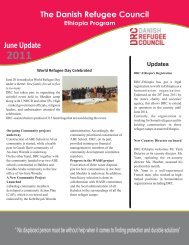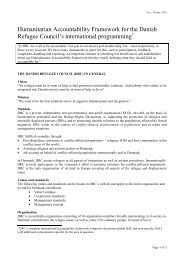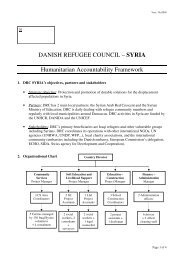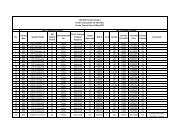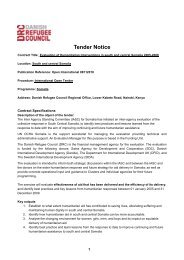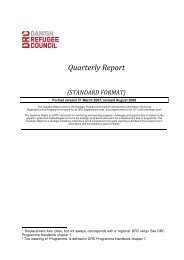Behind the Scenes, Kenya IDP Report - Danish Refugee Council
Behind the Scenes, Kenya IDP Report - Danish Refugee Council
Behind the Scenes, Kenya IDP Report - Danish Refugee Council
You also want an ePaper? Increase the reach of your titles
YUMPU automatically turns print PDFs into web optimized ePapers that Google loves.
Chapter 2:Setting <strong>the</strong> SceneThe Great Lakes region is said to be home to overeight million internally displaced persons. 10 <strong>IDP</strong>sare persons or groups of persons who have beenforced or obliged to flee or to leave <strong>the</strong>ir homes orplaces of habitual residence, in particular as a resultof or in order to avoid <strong>the</strong> effects of armed conflict,situations of generalised violence, violationsof human rights, natural or human-made disasters,and development programmes and who have notcrossed an internationally-recognised state border.11 Internal displacement within <strong>the</strong> region hasbeen caused by conflict, disaster, violence, massivedevelopment projects and socio-economicinequalities leading to landlessness among o<strong>the</strong>rthings. This population is distributed across all <strong>the</strong>nations that fall within <strong>the</strong> region and represents asignificant segment of global statistics on internaldisplacement. 12<strong>Kenya</strong> has a long history of displacement with aclimax in <strong>the</strong> aftermath of <strong>the</strong> 2007/ 2008 postelectionviolence. This section discusses some of<strong>the</strong> causes of violence in <strong>Kenya</strong> as a way of providinga context for understanding advocacy work fora policy on internal displacement.2.1. Causes of Displacement in<strong>Kenya</strong>2.1.1. Colonial and Post-ColonialFactorsThe introduction of colonisation saw <strong>the</strong> forceddisplacement of African communities from <strong>the</strong>irancestral lands to make way for <strong>the</strong> white settlers.In <strong>Kenya</strong>, this was exemplified in evictions fromfertile lands in Rift-Valley and Central <strong>Kenya</strong> where<strong>the</strong> natives were reduced to squatter-labour forcefor colonial settlers. At <strong>the</strong> time of independence,it was expected that this adverse legacy of colonialland alienation processes would be corrected. 13However, <strong>the</strong> post-independence governmentwent ahead to preside over a land re-distributionprogramme that instead became a fur<strong>the</strong>r sourceof discord. Initial land allocations in favour of personswho had been labourers on <strong>the</strong> settler farmsincensed <strong>the</strong> pastoralist communities of <strong>the</strong> RiftValley and fuelled <strong>the</strong> sentiment of “outsider communities”which continues to persist to this day.The situation was compounded by a programme toempower communities through formation of landbuyingcompanies which saw large-scale land acquisitionby communities perceived as close to <strong>the</strong>centre of power. This historical context infuseditself with <strong>the</strong> political and ethnic relations of<strong>Kenya</strong>n society and has become a cause of periodicpopulation movements and displacement in<strong>Kenya</strong>. 142.1.2. Election-related ViolenceMassive internal displacement in <strong>Kenya</strong> can betraced to <strong>the</strong> re-introduction of multi-party politicsin 1992 with political parties formed largelyalong ethnic lines becoming vehicles for championingredress for perceived communal injustices.This trend continued into <strong>the</strong> 1997 general elections,with violence registered in <strong>the</strong> Rift Valleyand Coast provinces leading to <strong>the</strong> displacementof 120,000 people. The victims were largely fromcommunities perceived as supporters of oppositionparties. In total, election-related violence priorto <strong>the</strong> 2007 general elections is said to have beenresponsible for <strong>the</strong> displacement of approximately350,000 persons. 15 Violence following <strong>the</strong> 2007general elections saw an escalated and unprecedentedlevel of displacement that affected 663,921people. 16 Areas affected by election-related dis-placement include mainly Molo, Njoro, Kuresoi,Eldoret, Burnt Forest, and Coastal region. 172.1.3. Border and ResourceDisputes Including CattleRustling and BanditryClosely associated with political conflict are borderdisputes arising from arbitrarily establishedadministrative boundaries and contested landrights. As administrative boundaries began to createethnic enclaves, minority communities within<strong>the</strong>se boundaries soon became <strong>the</strong> target of forcefulevictions. Areas such as Chesikaki in Mt. Elgon,Ol Moran in Laikipia West, Thangatha in Tigania,<strong>the</strong> Pokot/Turkana border, Riosiri in Rongo,Tembu in Sotik, Masurura in Transmara, Marsabit-Isioloand Tana River 18 have been particularlyproblematic in this regard. 19 Related to generaldisputes about resources is <strong>the</strong> evolution of cattlerustlingfrom a traditional practice to one of belligerenceand criminality fuelled by politics and <strong>the</strong>proliferation of small arms and light weapons. Pastoralistcommunities such as <strong>the</strong> Pokot, Turkana,Marakwet, Samburu, Tugen and Keiyo continue toendure incidences of displacement, death and lossof livestock over time 20 , as detailed in a 2003 studyon conflict in Nor<strong>the</strong>rn <strong>Kenya</strong> estimating <strong>the</strong> levelof displacement in <strong>the</strong> pastoralist areas of NorthFrontier Districts (NFDs) 21 in <strong>Kenya</strong> 22 at 164,457.2.1.4. Natural and Human MadeDisasters 23A historical profile from 1975-2004 indicatesthat <strong>Kenya</strong> has experienced multiple episodes ofdrought, landslides and floods in various parts of<strong>the</strong> country with far-reaching economic and socialconsequences. 24 <strong>Kenya</strong> experiences regular floodsin <strong>the</strong> areas of Kano, Nyakach, Rachuonyo, Migori,Budalangi, Kilifi, Kwale, <strong>the</strong> Tana River Basin, Garrissa,Wajir, Nairobi, Nakuru, Mombasa, Kisumu,Baringo, Elgeyo and Marakwet districts. 25 Landslidesand mudslides also occur mostly during <strong>the</strong>rainy season and are accelerated by flooding.2.1.5. Development Projects andDisplacement<strong>Kenya</strong>ns have also been displaced from <strong>the</strong>ir landsand homes on account of development projectsand environmental conservation efforts carriedout arbitrarily. A recent decision from <strong>the</strong> AfricanCommission on Human and Peoples’ Rights restored<strong>the</strong> land rights of <strong>the</strong> Endorois communitywho had been displaced from <strong>the</strong>ir ancestral landsto make way for a game reserve. 26 More recently,a taskforce recommended <strong>the</strong> eviction of personsdeemed to have encroached on <strong>the</strong> Mau Forestscomplex in a bid to conserve <strong>the</strong> country’s essentialwater towers. 27 As of September 2011, some6,500 families had been evicted from <strong>the</strong> complexwith a fur<strong>the</strong>r 23,500 projected for eviction once<strong>the</strong> next phase of restoration commences. 28 O<strong>the</strong>rprojects that may lead to displacement include<strong>the</strong> Lamu Port-Sou<strong>the</strong>rn Sudan-Ethiopia Transport(LAPSSET) project and <strong>the</strong> discovery of oil inTurkana. The LAPSSET project will comprise of aport, an international airport and an oil refinery inLamu along with a road and pipeline network cuttingacross <strong>Kenya</strong>, Ethiopia and Sou<strong>the</strong>rn Sudanand according to initial assessment by <strong>the</strong> governmentmay affect 6,000 families. 292.2. Towards a PolicyFrameworkFrom <strong>the</strong> very outset, it must be acknowledgedthat although before 2008 <strong>Kenya</strong> did not have asingle repository encompassing all its policies inrelation to internal displacement, such polices didexist. The policies existed as part of o<strong>the</strong>r laws, forinstance those relating to human rights, developmentplans, disaster response, compulsory acquisitionof land, armed conflict and laws on generaladministration. O<strong>the</strong>r policies existed not in writtenform but were employed through practice andmostly depended on <strong>the</strong> preferences and prioritiesof <strong>the</strong> government of <strong>the</strong> day. 30 What <strong>Kenya</strong> wasreally missing before <strong>the</strong> 2008 displacements wasa consistent and coordinated response to internaldisplacement. The Government did not expresslyrecognise <strong>the</strong> protection needs of <strong>IDP</strong>s, and inter-6<strong>Behind</strong> <strong>the</strong> <strong>Scenes</strong> – Lessons Learnt from Developing a National Policy Framework on Internal Displacement in <strong>Kenya</strong> 7







